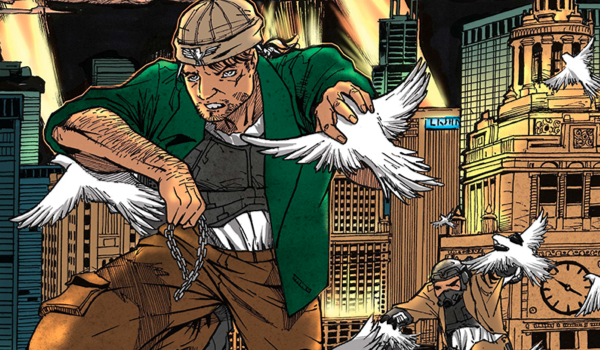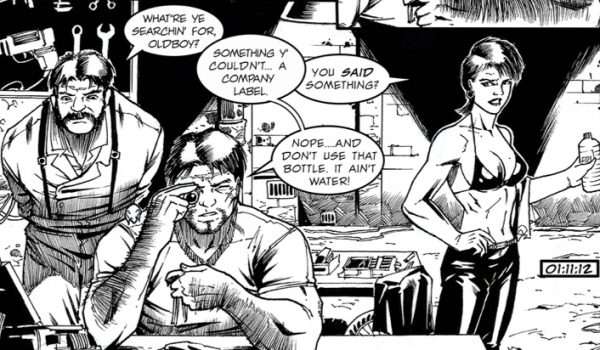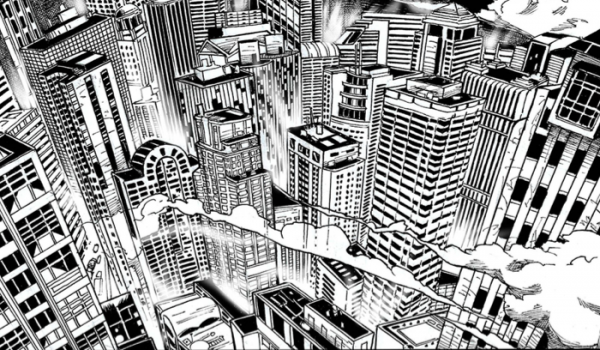Movement can be difficult to convey in comics. After all, we experience a story through a series of static images and the subtle suggestion of gesture must draw us along. Start messing with time and things get even more complicated. And it is this movement that plays such an integral role in Pramit Santra‘s Life-Time. Jumping through time and space, Life-Time is part sci-fi, part mystery, part thriller, but wholly infused with a steady stream of action. And as the story opens we find ourselves right in the heart of a cross-city chase.
Our protagonist, Frank, flees from a series of anonymous figures in vaguely militaristic uniforms. The opening scene has a sense of energy and urgency. It’s a speed and tension Santra maintains throughout the story. Though occasional jumps in time and locale may break the quick pace, such narrative leaps make up for occasional choppiness in variety.
But before these time jumps we have a runner, his pursuers, and Chicago. A discreet timer in the upper corner clues us in to the tricks about time. The second hand may be still, but the cast most certainly is not. Now, as mentioned, showing movement in comics is already something of a challenge. In illustrating a chase in an otherwise frozen world, Santra has not made the job any easier. Luckily Santra‘s dynamic art helps capture movement with a lively fluidity.
Characters also use the still landscape around them to unique purpose. Frank leaps across time-frozen birds in one of the most striking images in all of Life-Time (apparently time-freezing makes one much more tolerant to physical punishment. I don’t care how fleet-of-foot you are, a dove is not going to survive being used as an impromptu stepping stone. Don’t try this at home kids). Frank further manipulates his environment to lethal effect against his pursuers. Santra uses time-stopping technology in what is perhaps the most original manner in fiction. But it’s only when Frank meets Santra‘s other protagonists that the real mystery begins.
The detail of Santra‘s world is obvious when Frank meets his friend/colleague Mariah. They start talking shop immediately. While their discussion illustrates Santra‘s larger system, with so little to go on it can also be difficult to follow. I suspect things will be clearer in hind-sight, but at the moment it’s all too easy to gloss over the dialogue and miss potential clues. As of the second installation, we’re still only getting hints at the larger mysteries.
These mysteries play out through three different times and places. Interspersed with the main 1990s story there are two about a third protagonist, Viktor. He first shows up in Frank’s Chicago hideout before we jump back to 19th century France and forward again to a Nazi concentration camp. Each narrative plays into one another, drawing towards some larger plot. Whatever answers exist are firmly rooted in the past.
The mystery and tension propel all three stories. As for myself, I’m most interested in the past tales. This is in large part due to personal bias- I’m a sucker for historical fiction with touches of the fantastic. And not only does Viktor’s past illustrate his remarkable youth but also the origins of time manipulation. And maybe I’m just overly fond of watching Jews punch Nazis and blow up their camps, but Viktor’s 1940s exploits just warm the cold husk that was once my heart.
That said he also comes off well in comparison to Frank. Frank is a very particular type of action hero. He’s hard, strong, tough, doesn’t take any shit or stand on ceremony. At best, these types come across as complex, intimidating figures. At worst, they are flat caricatures of masculinity. Frank rarely bothers with things like subtly or consideration. Whether he’s making snide comments at a couple mid-coitus or pontificating on rape statistics (specifically claiming that women never rape men- a statement I am compelled to point out is categorically false), Frank maintains this rough attitude.
I am not entirely opposed to such iterations of the “Tough Guy”, but it’s a delicate job to keep a badass from becoming an asshole. Of course, no one ever said a protagonist has to be likable, and perhaps Santra is setting him up for some character development, but at the moment Frank can become grating. I found that he became much more relatable and interesting in softer social situations, for instance, chatting with Mariah about piloting a plane. These humanizing moments go a long way to making Frank not only more sympathetic, but also more realistic.
As for Mariah, well, we know relatively little about her at this point in the story. Like Frank she can veer towards “Heartless Action Girl”, and like Frank she’s most interesting when revealing more of her humanity. She certainly has lots of potential for personal growth with hints of a family and a life long left behind.
However, her character design can be a little distracting (admittedly, I suspect this is a feature, not a bug). You see Mariah has gravity-defying breasts. Now, the human breast is a subject near and dear to my heart (see what I did there?) so it can be a little unnerving to see them lift and separate all on their own. This is a pretty common anatomical issue in comics from every genre and publisher. It’s not enough to stop me from enjoying a story, but it still distracts from the general aesthetic. That said, I do like to see a comic lady with some muscles. All too often heroines are shown preforming superhuman feats of strength and endurance while possessing the muscle definition of a overcooked noodle. Mariah is a refreshing exception.
Aside from some slight anatomical issues and the occasional case of Same-Face Syndrome, Life-Time‘s art is solid and dynamic. Santra truly shines when it comes to illustrating setting and scene. There’s an excellent grasp of architecture, flow, and a more abstract sense of place. Detailed without being cluttered and clear without being dull, Santra‘s masterfully created landscapes are lively across time and place. Furthermore, their grasp of action keeps motion fluid and graceful, a very important quality to have in such a fast paced comic.
Overall, Life-Time is a promising thriller of many paths. Through various genres and settings, Santra is quite clearly working towards a more unified narrative. It will be interesting to see with how much grace the characters execute their plans. Pick up a copy if you want mystery, action, and a detailed sci-fi universe.
What interests you about Life-Time? Sound off in the comments or send us your thoughts on Facebook or Twitter!




